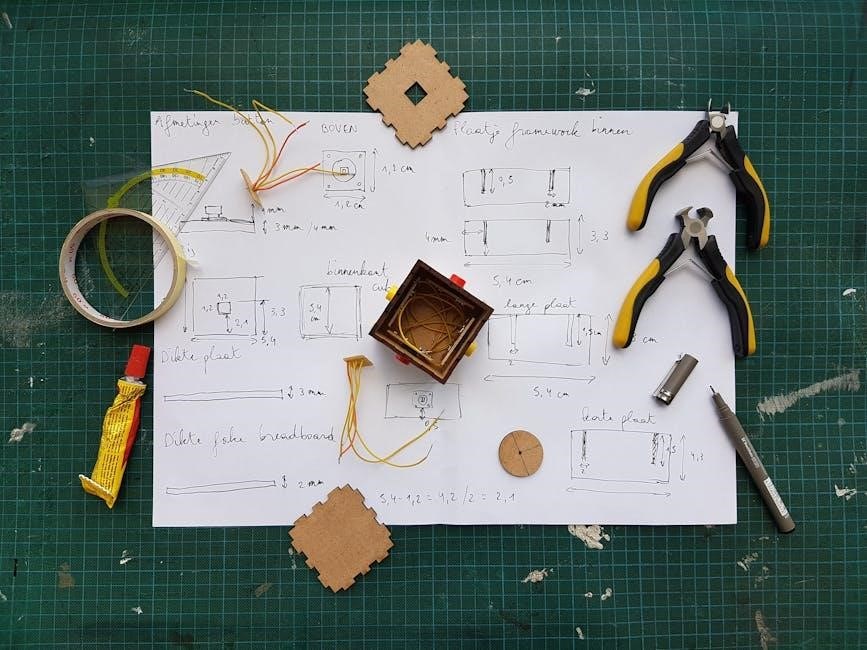Kenmore Bread Maker Manual: A Comprehensive Guide

Kenmore bread maker manuals offer essential instructions for various models.
They detail features‚ operation‚ and safety precautions‚ guiding users to create diverse bread types‚ programming loaf sizes and crust colors.
Kenmore bread makers stand out as incredibly useful small appliances for any modern kitchen‚ offering a convenient way to bake fresh‚ homemade bread with minimal effort.
These machines are designed to simplify the bread-making process‚ from kneading to baking‚ delivering consistent and professional-quality loaves every time.
With a Kenmore bread maker‚ you can easily whip up a variety of bread types‚ ranging from classic white to more complex and artisanal varieties.
The versatility of these machines extends beyond basic bread‚ allowing you to create dough for pizzas‚ cakes‚ and other baked goods.
Kenmore bread makers are equipped with user-friendly controls and pre-programmed settings‚ making them accessible to both novice and experienced bakers.
Many models also feature options for adjusting loaf size and crust color‚ ensuring that your bread is baked exactly to your preferences.
Whether you’re looking to enjoy the taste of freshly baked bread or experiment with new recipes‚ a Kenmore bread maker is a valuable addition to any home.

Finding Your Kenmore Bread Maker Manual
Locating your Kenmore bread maker manual is crucial for proper operation and maintenance.
Several online resources and model identification methods can assist you in finding the correct manual for your specific bread maker.

Online Resources for Manuals
Finding your Kenmore bread maker manual online is easier than ever‚ offering quick access to essential information.
Sears Parts Direct is a valuable resource‚ providing manuals and parts diagrams for various Kenmore models.
The Internet Archive hosts user manuals‚ like the Kenmore 48487 and 100.12934 manuals‚ available for download.
Many websites offer free PDF downloads of Kenmore bread maker manuals‚ allowing you to view them on your computer or mobile device.
Kenmore’s official website often provides product manuals in their support section‚ searchable by model number.
Online forums and communities dedicated to appliances can also be helpful‚ with members sharing manuals and troubleshooting tips.
Always ensure the manual you download matches your specific Kenmore bread maker model to avoid incorrect instructions.
These online resources make it convenient to find the manual you need‚ ensuring you can operate your bread maker safely and efficiently.
Model Number Identification
Locating your Kenmore bread maker’s model number is crucial for finding the correct manual and replacement parts. Typically‚ the model number is printed on a sticker or plate affixed to the appliance.
Check the bottom of the bread maker‚ the back panel‚ or inside the bread pan compartment.
The model number is often a combination of numbers and letters‚ such as “100.12934” or “48487”.
Write down the complete model number‚ as it’s essential for searching online or contacting customer support.
Once you have the model number‚ you can easily find the corresponding manual on resources like Sears Parts Direct or the Kenmore website.
Knowing the model number also helps ensure you order the correct replacement parts if needed.
If you’re having trouble locating the model number‚ consult the original packaging or purchase receipt.
Identifying the model number accurately ensures you receive the right information and support for your specific Kenmore bread maker.

Key Features and Functions Explained
Kenmore bread makers offer various features such as loaf size selection‚ crust color control‚ dough programs‚ and rapid bake options.
The manual details how to use these functions effectively.
Loaf Size and Crust Color Settings
Kenmore bread makers allow users to customize their bread with adjustable loaf size and crust color settings.
The manuals provide detailed instructions on selecting the desired loaf size‚ typically ranging from small to large‚ influencing the final product’s volume.
Crust color settings‚ ranging from light to dark‚ affect the bread’s outer texture and appearance.
The user manual explains how to navigate the control panel to choose the appropriate settings for each recipe.
Experimenting with these settings allows users to achieve their preferred bread characteristics‚ tailoring the bread to their specific tastes.
Understanding these settings ensures optimal results and consistent bread quality.
Users can refer to the manual for specific recommendations and tips for using these settings to create a variety of bread types.
The Kenmore bread maker manual also provides guidance on troubleshooting any issues related to loaf size or crust color.
Dough and Baking Programs
Kenmore bread makers feature a variety of pre-programmed dough and baking programs.
These programs simplify the bread-making process by automating mixing‚ kneading‚ rising‚ and baking stages.
The user manual details each program’s specific functions‚ including dough-only options for pizza or rolls.
Baking programs cater to different bread types like white‚ wheat‚ or sweet bread‚ adjusting temperature and time accordingly.
The manual provides guidance on selecting the appropriate program based on the recipe and desired outcome.
Understanding these programs ensures consistent and professional-quality bread loaves.
Users can refer to the manual for troubleshooting tips related to program selection or performance.
The Kenmore bread maker manual outlines the steps for creating customized bread recipes by manually adjusting program settings.
This allows experienced bakers to fine-tune their bread-making process for optimal results.
The manual provides a comprehensive overview of the various programs‚ empowering users to explore the full potential of their Kenmore bread maker.
Rapid Bake Function
The rapid bake function on Kenmore bread makers offers a faster alternative to standard baking cycles.
This feature reduces the overall bread-making time‚ ideal for users with busy schedules.
The Kenmore bread maker manual provides specific instructions on using the rapid bake setting.
It highlights potential differences in texture and rise compared to traditional baking methods.
The manual advises adjusting ingredient quantities slightly to optimize results with the rapid bake function.
Users should consult the manual for recommended recipes specifically designed for rapid baking.
The rapid bake function may not be suitable for all bread types‚ as denser breads may require longer baking times.
The Kenmore bread maker manual offers troubleshooting tips for common issues encountered when using the rapid bake setting.
These may include uneven baking or a less-than-ideal crust.
Understanding the limitations and adjustments necessary for the rapid bake function is crucial for successful bread making.
The manual guides users on selecting the appropriate loaf size and crust color settings in conjunction with rapid baking.

Operating Instructions
Kenmore bread maker manuals offer a step-by-step guide.
The instructions cover everything from ingredient preparation to bread removal.
The manual ensures users can easily operate their Kenmore bread machine for perfect results.
Step-by-Step Guide to Bread Making
The Kenmore bread maker manual provides a detailed‚ step-by-step guide to ensure successful bread making.
First‚ open the lid and remove the bread pan using the bread pan handle.
Position the kneading blade inside the bread pan‚ ensuring it’s securely attached.
Add ingredients in the order specified in your recipe‚ usually liquids first‚ followed by dry ingredients and yeast last.
Place the bread pan back into the machine and close the lid.
Select your desired program using the control panel‚ choosing the appropriate loaf size and crust color.
Press the start button to begin the bread-making process.
The machine will automatically knead‚ rise‚ and bake the bread.
Monitor the progress through the viewing window‚ if available.
Once the baking cycle is complete‚ the machine will beep to signal it’s finished.
Carefully remove the bread pan using oven mitts‚ as it will be hot.
Let the bread cool slightly before removing it from the pan and slicing.
Ingredient Measurement and Preparation
Accurate ingredient measurement and preparation are crucial for successful bread making with your Kenmore bread maker.
Always use measuring cups and spoons specifically designed for baking.
Liquids should be measured in liquid measuring cups‚ while dry ingredients should be measured in dry measuring cups‚ leveled with a straight edge.
Ensure that all ingredients are fresh and at room temperature‚ unless the recipe specifies otherwise;
Yeast is a particularly sensitive ingredient‚ so check the expiration date and store it properly.
Measure the yeast carefully‚ as too much or too little can affect the bread’s rise.
Flour should be measured accurately‚ avoiding packing it into the measuring cup.
For best results‚ sift the flour before measuring to ensure a consistent texture.
Cut butter or other fats into small pieces for even distribution throughout the dough.
Pre-measure all ingredients before starting the bread-making process to avoid errors.
Following these guidelines will help you achieve consistent and delicious bread every time.
Removing the Bread Pan and Loaf

Once the baking cycle is complete‚ carefully remove the bread pan from your Kenmore bread maker.
Always use oven mitts or pot holders to protect your hands from the heat‚ as the pan will be very hot.
Open the lid of the bread maker and locate the bread pan handle.
Lift the handle to release the pan from the machine.
Gently shake the pan to loosen the loaf from the sides.
If the loaf is stuck‚ use a non-metallic spatula to carefully separate it from the pan.
Avoid using metal utensils‚ as they can scratch the non-stick coating.
Invert the bread pan onto a wire rack to allow the loaf to cool.
Let the bread cool for at least 15-20 minutes before slicing.
This allows the bread to firm up and prevents it from becoming gummy.
If the kneading blade remains in the loaf‚ carefully remove it with a non-metallic tool.
Enjoy your freshly baked bread! Be cautious‚ the bread will be hot.

Safety Precautions
When operating your Kenmore bread maker‚ it’s crucial to adhere to safety precautions to prevent accidents and ensure longevity.
Always place the bread maker on a stable‚ heat-resistant surface away from water.
Never immerse the appliance in water or any other liquid.
Keep the bread maker out of reach of children‚ especially during operation‚ to avoid burns.
Do not touch hot surfaces during or immediately after baking‚ use oven mitts when handling the bread pan.
Ensure proper ventilation around the bread maker to prevent overheating.
Unplug the appliance when not in use and before cleaning.
Never operate the bread maker if the cord or plug is damaged.
If the bread maker malfunctions‚ do not attempt to repair it yourself.
Refer to a qualified technician for repairs.
Avoid using abrasive cleaners or scouring pads on the bread pan.
Always allow the bread maker to cool completely before cleaning.
Failure to follow these guidelines could result in injury or damage. Keep children away from the machine when it is operating.

Troubleshooting Common Issues

Encountering issues with your Kenmore bread maker can be frustrating‚ but many problems have simple solutions.
If the bread doesn’t rise‚ ensure your yeast is fresh and properly measured.
Check the expiration date and store yeast in a cool‚ dry place.
If the loaf is too dense‚ reduce the amount of flour or increase the liquid slightly.
A sticky dough may indicate too much liquid; add a tablespoon of flour at a time until the consistency improves.
If the bread maker stops during operation‚ check the power cord and outlet.
Ensure the bread pan is securely locked in place.
If the kneading blade gets stuck‚ soak the bread pan in warm water to loosen any hardened dough.
Uneven baking could be due to improper ingredient measurement; use measuring cups and spoons accurately.
If the crust is too dark‚ select a lighter crust setting or reduce the baking time.
A collapsed loaf might result from too much yeast or letting the dough proof for too long.
Consult your Kenmore manual for specific troubleshooting tips related to your model.